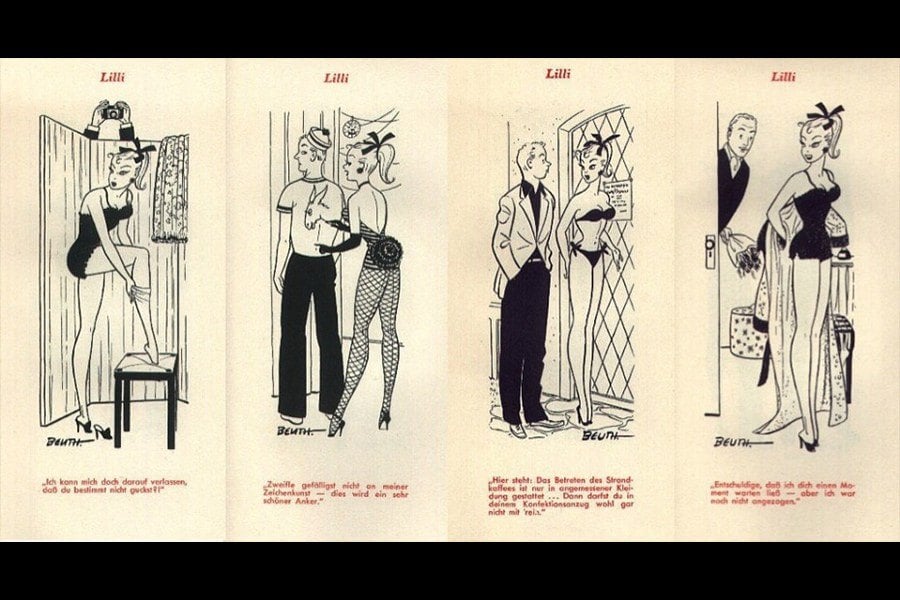Meet Bild Lilli, the dirty little secret Barbie creators hoped everyone would forget

Wikimedia CommonsThe original Barbie (left), compared with Bild Lilli.
The Barbie doll has long been the symbol of the all-American woman. She’s known as much for her good looks and her extensive wardrobe as she is her impressive list of careers. Yet Barbie’s origins aren’t as innocent — or American — as you might think.
In 1956, Ruth Handler and her daughter, Barbara, went on vacation in Switzerland. There, Barbara took a liking to a German doll called Lilli. Handler decided to bring three of the dolls back home with her, where she sought to pitch a similar idea to her husband/business partner — a co-founder of Mattel.
It worked. By 1959, Mattel’s version of Lilli, called Barbie, was on the shelves and marketed for little girls. But Barbie’s predecessor had a much more mature — and racy — backstory.
In 1952, cartoonist Reinhard Beuthien first drew the Lilli character to fill an empty slot in the tabloid Bild-Zeitung. Beuthien made Lilli a sex-kitten — uninhibited, witty, and independent. She supported herself as a secretary, but often dated older men for their money.
In one cartoon, Lilli appears naked except for newspaper to cover her body, telling a friend, “We had a fight and he took back all the presents he gave me.” In another, Lilli wears a bikini as a policeman tells her that such a revealing two-piece outfit has been banned, to which she quips, “Oh, and in your opinion, which part should I take off?”

Messy Nessy ChicBild Lilli comic strips from the 1950s.
Lilli became a sensation. According to Time, Lilli was so popular that tobacco shops, bars, and “adult-themed toy stores” started selling a plastic doll version of her.
This Bild Lilli doll was a platinum blonde, blue-eyed bombshell with large breasts. She wore red lipstick and blue eyeliner. Her feet were molded into black stilettos and she had arched eyebrows and sultry side-glancing eyes.
The doll epitomized the pervasive male ideals of feminine beauty and charm, crafted to emulate real-life objects of men’s desires.
However, young girls coveted Bild Lilli too. In order to cash in on this burgeoning market, manufacturers soon sold furniture and doll houses for Bild Lilli separately.
Thus, Ruth Handler looked at Bild Lilli and saw an opportunity. After presenting the doll to Mattel, Handler made some slight modifications, including giving the doll real feet and removing its earrings.
Handler then debuted her creation, dubbed the Barbie doll, named for her daughter, at the 1959 American International Toy Fair. The original Barbie shared almost all its physical attributes with its German counterpart. In fact, Barbie’s eyes, like Bild Lilli’s, were made to glance to the side and weren’t modified to look forward until 1971.

MATT CAMPBELL/AFP/Getty ImagesRuth Handler holding a Barbie doll at a 40th anniversary celebration for her famous creation in 1999.
But copying Bild Lilli wouldn’t be as easy as Mattel thought. In 1961, Greiner & Hauser, which manufactured Bild Lilli, sued Mattel for infringing on its revolutionary patent for Bild Lilli’s hip joint. Lawyers settled the suit out of court two years later, and in 1964 Mattel bought the copyright and patents for Bild Lilli.
From that point on, Mattel owned the dirty little secret of Barbie’s birth and buried it as deep as possible. Still, as Barbie rose to the top of the toy world, America’s favorite doll drummed up some more controversies of its own.
For one, Barbie has been accused of perpetuating negative body image issues in young women because of the doll’s tiny waist and large bust — an unattainable figure for most women. One survey from 2006 found that girls exposed to Barbie “reported lower body esteem and greater desire for a thinner body shape.”
Despite such claims, Ruth Handler defended Barbie to the end. In 1977, she told the New York Times:
“Every little girl needed a doll through which to project herself into her dream of her future. If she was going to do role playing of what she would be like when she was 16 or 17, it was a little stupid to play with a doll that had a flat chest. So I gave it beautiful breasts.”
Although Barbie has created body image controversy, the doll’s ambitious career goals — she’s been, among other things, an astronaut, air force pilot, and a baseball player, jobs usually reserved for men — have, as the Economist wrote, inspired “girls to become anything they want.”
And whichever position you take on Barbie, the controversy surrounding the doll isn’t likely to dissipate anytime soon. We are, after all, talking about an American girls’ doll born of a German sex kitten.





